Modan Reveals Its Third Menu, The Global Asian Leg | ABS-CBN
ADVERTISEMENT

Welcome, Kapamilya! We use cookies to improve your browsing experience. Continuing to use this site means you agree to our use of cookies. Tell me more!
Modan Reveals Its Third Menu, The Global Asian Leg
Modan Reveals Its Third Menu, The Global Asian Leg
Ching Dee
Published May 20, 2024 02:03 PM PHT
|
Updated May 20, 2024 08:34 PM PHT
More than a year after it opened, I finally had the opportunity to experience the sought-after degustation dinner at Mōdan by award-winning chef Jorge Mendez.
More than a year after it opened, I finally had the opportunity to experience the sought-after degustation dinner at Mōdan by award-winning chef Jorge Mendez.
 Mōdan's iconic signage Ching Dee
Mōdan's iconic signage Ching Dee
 Mōdan's iconic signage Ching Dee
Mōdan's iconic signage Ching Dee I’d like to preface this by sharing that our dinner was a wedding gift from Chef Jorge himself, but it doesn’t take away from the fact that the food was stellar and the service was *chef’s kiss* impeccable.
I’d like to preface this by sharing that our dinner was a wedding gift from Chef Jorge himself, but it doesn’t take away from the fact that the food was stellar and the service was *chef’s kiss* impeccable.
The concept of blending neo-traditional Japanese techniques with flavors from across Asia sounded both intriguing and mouthwatering. Their third and current menu, titled the “Global: Asian Leg,” showcases dishes inspired by Chef Jorge’s travels through Asia, infusing his favorite Asian dishes with progressive Japanese touches.
The concept of blending neo-traditional Japanese techniques with flavors from across Asia sounded both intriguing and mouthwatering. Their third and current menu, titled the “Global: Asian Leg,” showcases dishes inspired by Chef Jorge’s travels through Asia, infusing his favorite Asian dishes with progressive Japanese touches.
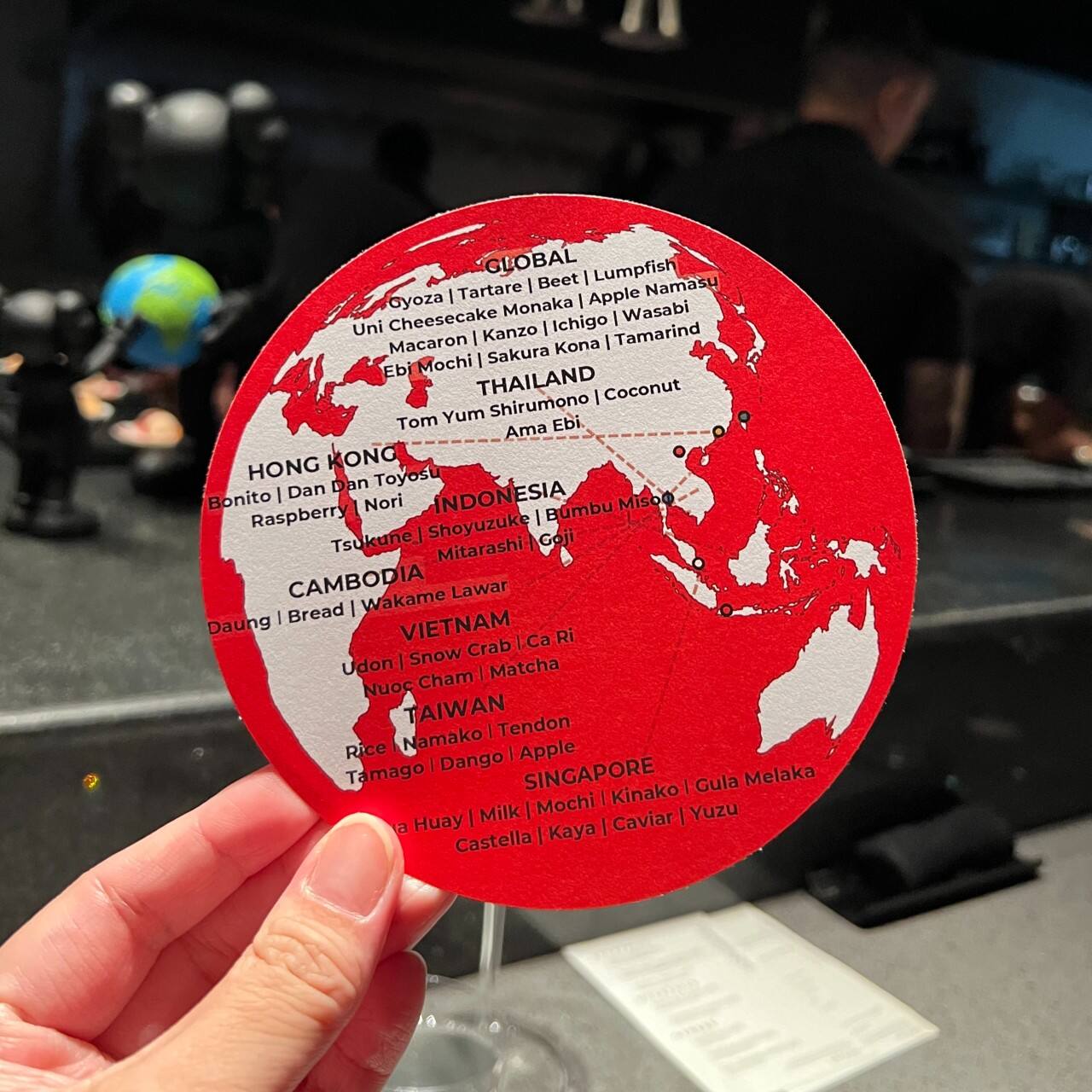 The menu is a map of Asia Ching Dee
The menu is a map of Asia Ching Dee
 The menu is a map of Asia Ching Dee
The menu is a map of Asia Ching Dee The meal began with an array of SNACKS that immediately set the tone for the evening. The night started off with a freakin’ bang, to say the least.
The meal began with an array of SNACKS that immediately set the tone for the evening. The night started off with a freakin’ bang, to say the least.
ADVERTISEMENT
Gyoza
The deep-fried gyoza had a delicate wrapper encasing a tartare that was both rich and light, complemented by the earthiness of beet and the ever-so-subtle briny flavor of lumpfish.
The deep-fried gyoza had a delicate wrapper encasing a tartare that was both rich and light, complemented by the earthiness of beet and the ever-so-subtle briny flavor of lumpfish.
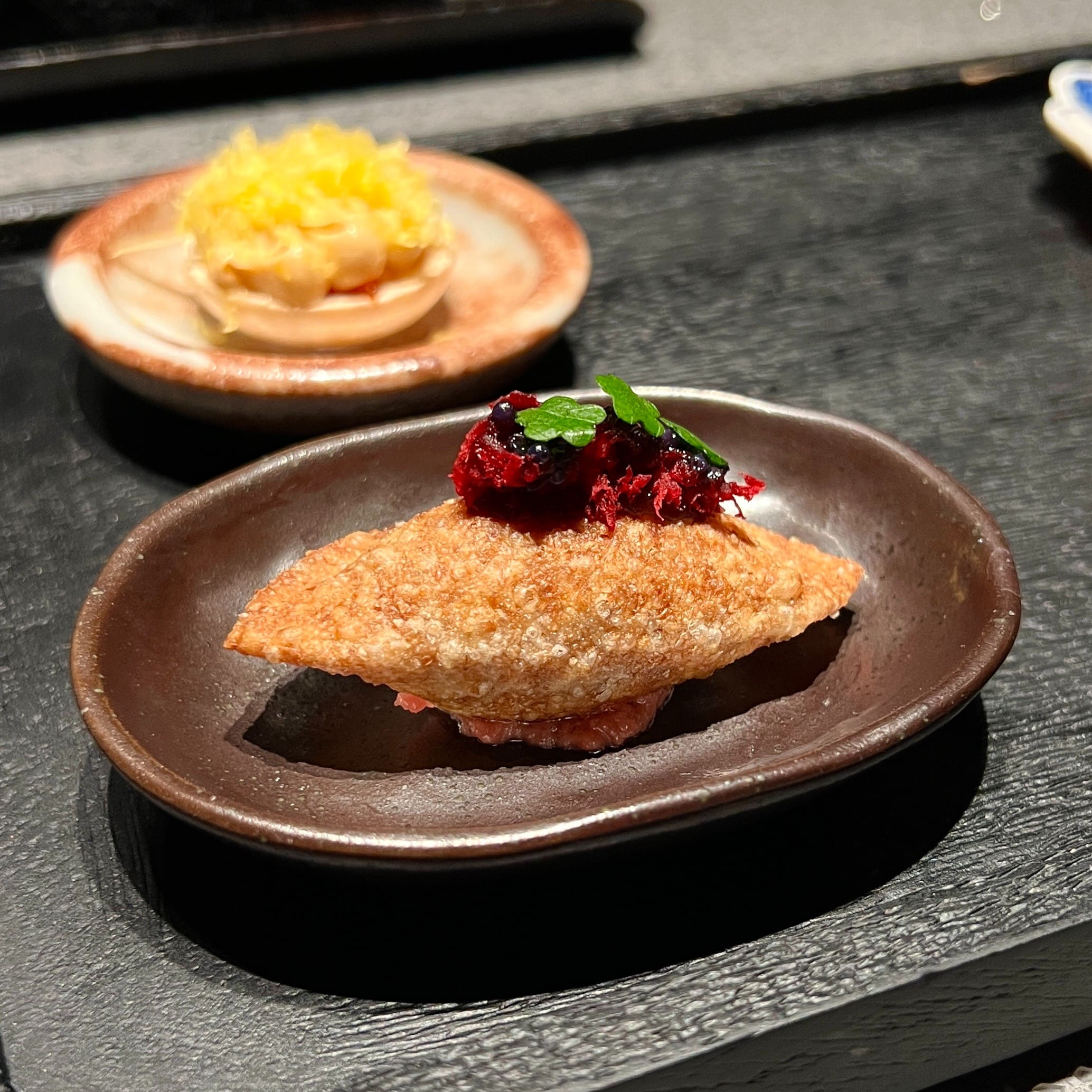 Gyoza Ching Dee
Gyoza Ching Dee
 Gyoza Ching Dee
Gyoza Ching Dee Uni Cheesecake
This unique and savory take on cheesecake features monaka, a crisp wafer that served as a teeny-weeny crust, that beautifully contrasts the savory creaminess of the uni-flavored cheesecake. The uni (sea urchin) flavor paired so well with apple namasu, a Japanese-style pickled apple that cuts through the richness of the uni.
This unique and savory take on cheesecake features monaka, a crisp wafer that served as a teeny-weeny crust, that beautifully contrasts the savory creaminess of the uni-flavored cheesecake. The uni (sea urchin) flavor paired so well with apple namasu, a Japanese-style pickled apple that cuts through the richness of the uni.
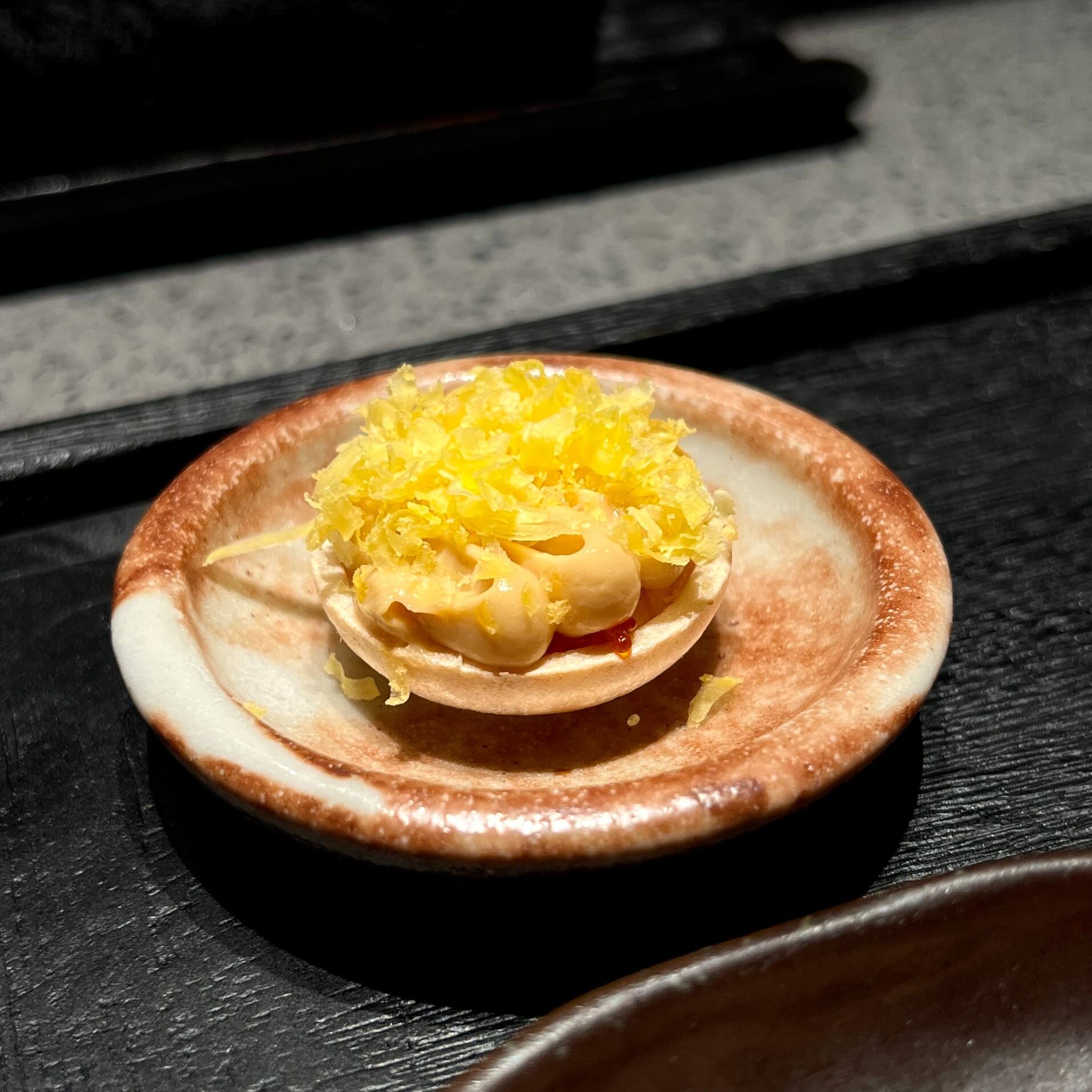 Uni Cheesecake Ching Dee
Uni Cheesecake Ching Dee
 Uni Cheesecake Ching Dee
Uni Cheesecake Ching Dee Macaron
This playful dish featured a single bite-sized macaron combined with the flavors of kanzo (licorice root), ichigo (strawberries), and a surprising kick of wasabi. The tangy sweetness of the strawberry and the unique heat of the wasabi played off each other beautifully.
This playful dish featured a single bite-sized macaron combined with the flavors of kanzo (licorice root), ichigo (strawberries), and a surprising kick of wasabi. The tangy sweetness of the strawberry and the unique heat of the wasabi played off each other beautifully.
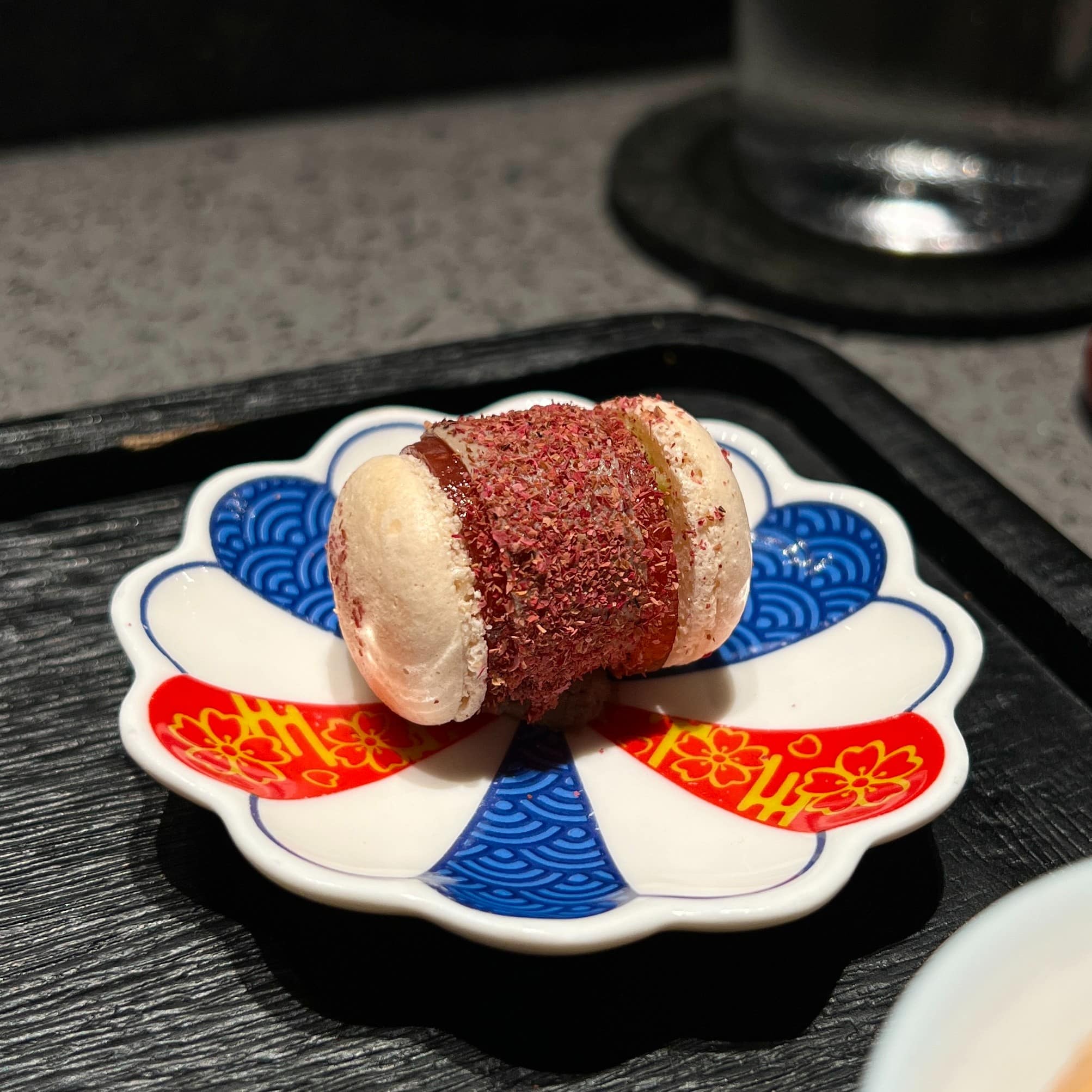 Macaron Ching Dee
Macaron Ching Dee
 Macaron Ching Dee
Macaron Ching Dee Ebi Mochi
The ebi (shrimp) mochi, with its soft, chewy texture, went well with the sakura kona (what seems to be cherry blossom powder) and had a tamarind sauce underneath, adding a tangy and floral note to the end of this course. The shrimp has a natural sweetness which also worked well with the tamarind sauce.
The ebi (shrimp) mochi, with its soft, chewy texture, went well with the sakura kona (what seems to be cherry blossom powder) and had a tamarind sauce underneath, adding a tangy and floral note to the end of this course. The shrimp has a natural sweetness which also worked well with the tamarind sauce.
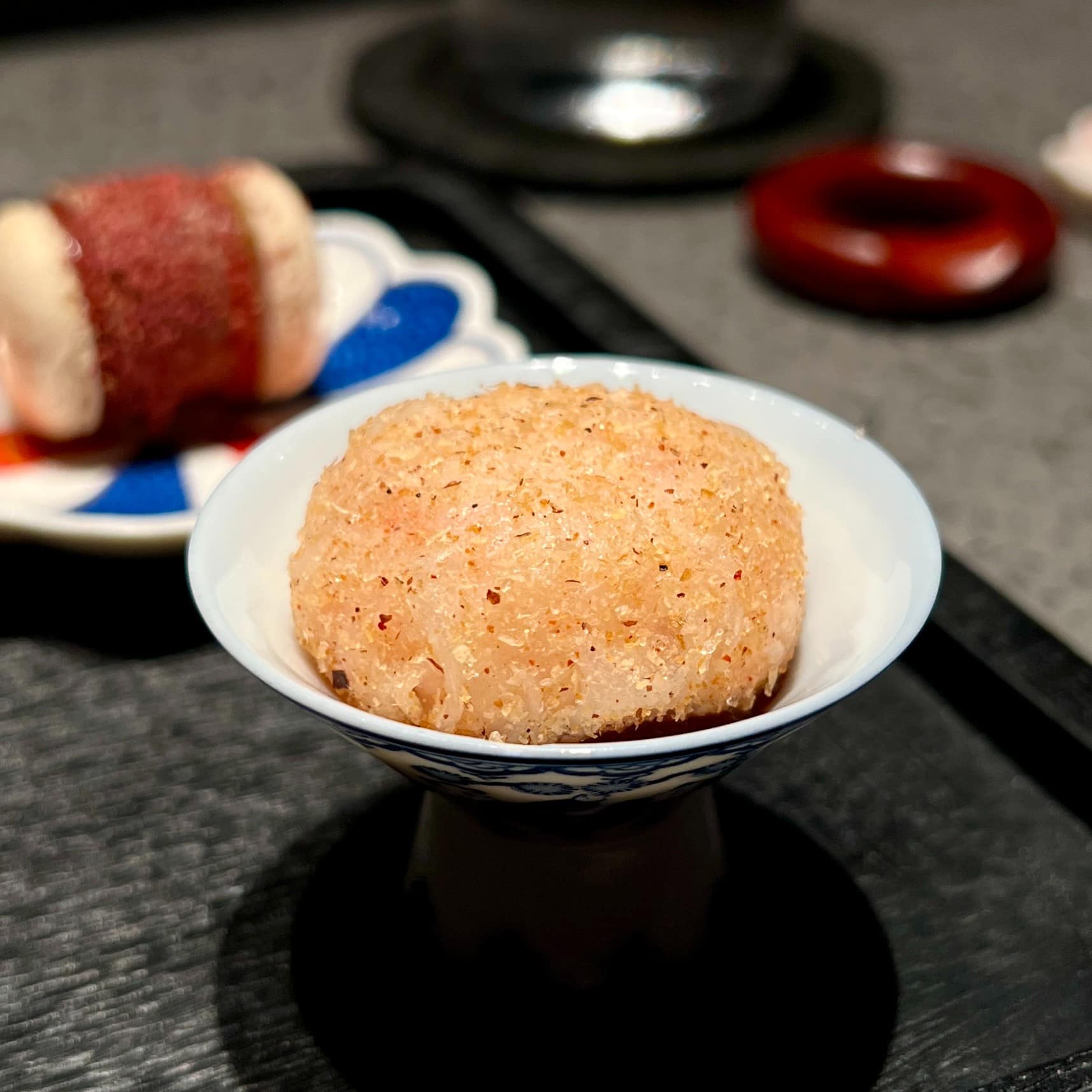 Ebi Mochi Ching Dee
Ebi Mochi Ching Dee
 Ebi Mochi Ching Dee
Ebi Mochi Ching Dee THAILAND
This dish was a delightful interpretation of the classic Thai soup, Tom Yum, giving it the Shirumono (Japanese soup) treatment. The broth was infused with aromatic herbs and spices, enriched with creamy coconut custard (almost like chawan mushi) at the bottom of the bowl. True to Tom Yum fashion but slightly elevated, this dish has ama ebi (Japanese sweet shrimp), adding a delicate sweetness to the spicy, sour profile of the broth. I shamelessly drank the broth, bottoms up, because I didn’t want to waste a single drop of that broth.
This dish was a delightful interpretation of the classic Thai soup, Tom Yum, giving it the Shirumono (Japanese soup) treatment. The broth was infused with aromatic herbs and spices, enriched with creamy coconut custard (almost like chawan mushi) at the bottom of the bowl. True to Tom Yum fashion but slightly elevated, this dish has ama ebi (Japanese sweet shrimp), adding a delicate sweetness to the spicy, sour profile of the broth. I shamelessly drank the broth, bottoms up, because I didn’t want to waste a single drop of that broth.
It’s remarkably close to Chef Jorge’s Tom Yum at Some Thai, his newly opened restaurant in Tomas Morato. Granted, the one at Mōdan has fancier elements, the heartiness and essence of Tom Yum — influenced by his many visits to The Land of Smiles — are present in both establishments.
It’s remarkably close to Chef Jorge’s Tom Yum at Some Thai, his newly opened restaurant in Tomas Morato. Granted, the one at Mōdan has fancier elements, the heartiness and essence of Tom Yum — influenced by his many visits to The Land of Smiles — are present in both establishments.
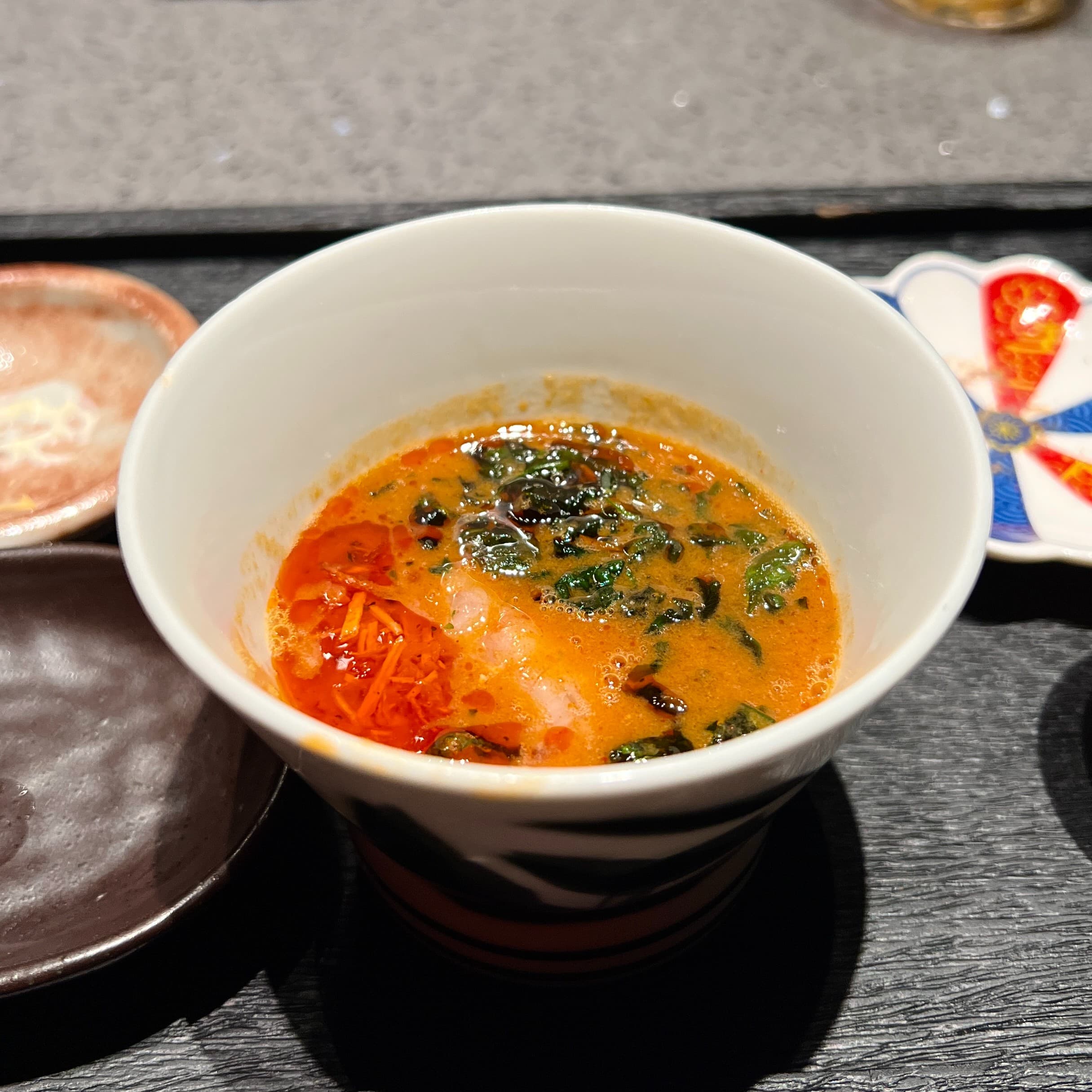 Thailand Ching Dee
Thailand Ching Dee
 Thailand Ching Dee
Thailand Ching Dee Related Story: Jorge Mendez's Fabulously Inauthentic Thai Restaurant
HONG KONG
Inspired by Chef Jorge’s travels to the chaotic beauty that is Hong Kong, this dish combines generous slices of bonito sashimi with the creamy goodness of their own Dan Dan Toyosu, a nod to the famous Dan Dan noodles, paired with the tartness of raspberries and the glass-like shards of caramelized nori (seaweed). As beautiful as the dish is, it is meant to be mixed together so the whipped dan dan sauce coats the sashimi bonito and makes sure you get a little bit of all elements in each bite. The result is something so straightforward yet so complex. Masterful is just one way to describe it. It’s so easy to overpower sashimi since it’s so delicate, but the components of the dish didn’t mask the bonito’s fresh flavors, it complemented it.
Inspired by Chef Jorge’s travels to the chaotic beauty that is Hong Kong, this dish combines generous slices of bonito sashimi with the creamy goodness of their own Dan Dan Toyosu, a nod to the famous Dan Dan noodles, paired with the tartness of raspberries and the glass-like shards of caramelized nori (seaweed). As beautiful as the dish is, it is meant to be mixed together so the whipped dan dan sauce coats the sashimi bonito and makes sure you get a little bit of all elements in each bite. The result is something so straightforward yet so complex. Masterful is just one way to describe it. It’s so easy to overpower sashimi since it’s so delicate, but the components of the dish didn’t mask the bonito’s fresh flavors, it complemented it.
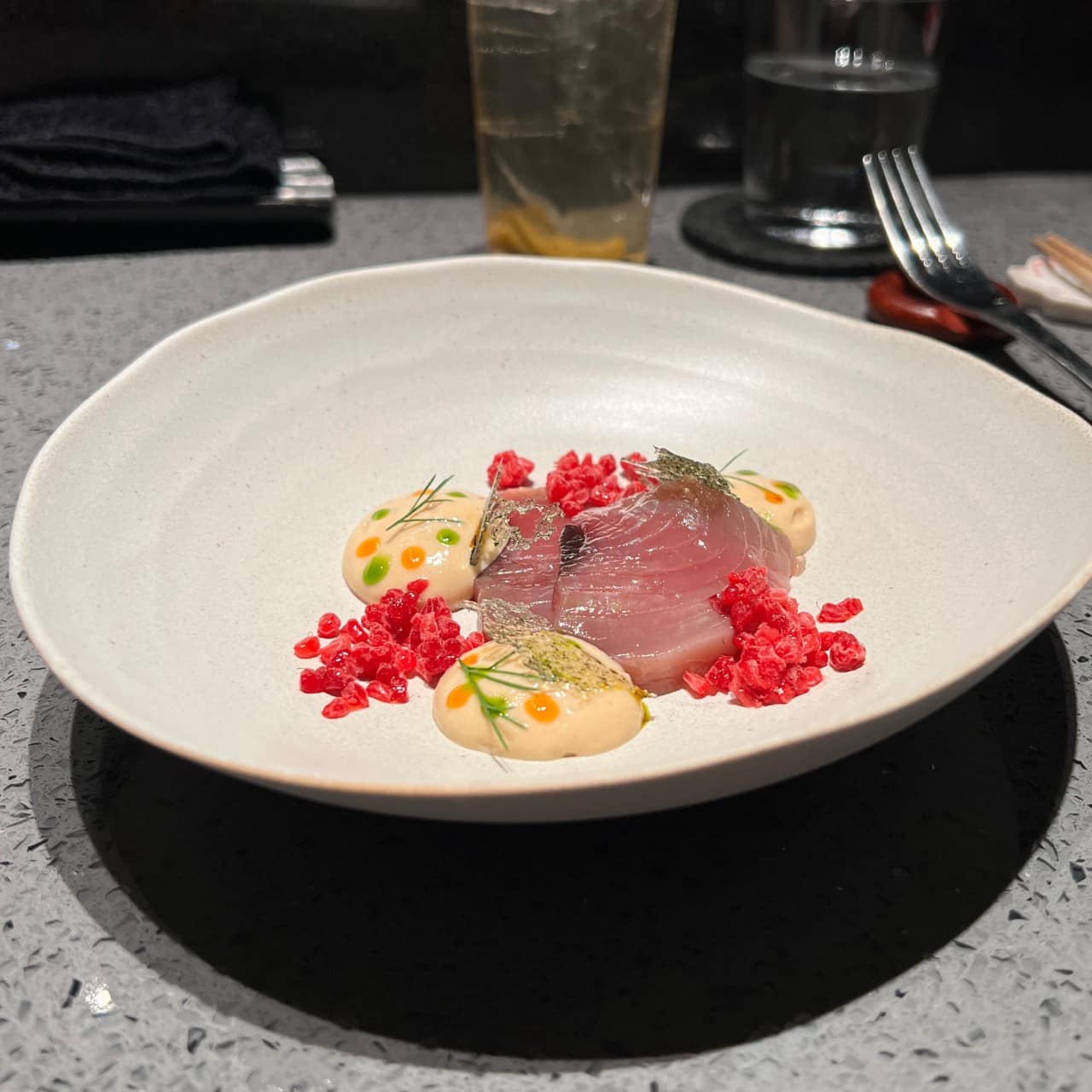 Hong Kong Ching Dee
Hong Kong Ching Dee
 Hong Kong Ching Dee
Hong Kong Ching Dee INDONESIA
This is my absolute favorite from the entire evening. I still dream of this dish, hoping I could just order a tub of the sauce and a bucket of these tebasaki wings. It was glorious.
This is my absolute favorite from the entire evening. I still dream of this dish, hoping I could just order a tub of the sauce and a bucket of these tebasaki wings. It was glorious.
It features tebasaki-style chicken wings stuffed with tsukune (ground chicken, usually formed into meatballs). Freshly fried and still sizzling, the wings are glazed with what I assume is the mitarashi (sweet soy sauce usually used to glaze Japanese dango or mochi balls) and served in a nest. It’s accompanied by a sauce of bumbu miso, a traditional Indonesian spice mix, and shoyuzuke (soy sauce-based condiment), soy-marinated egg yolk, and some goji berries.
It features tebasaki-style chicken wings stuffed with tsukune (ground chicken, usually formed into meatballs). Freshly fried and still sizzling, the wings are glazed with what I assume is the mitarashi (sweet soy sauce usually used to glaze Japanese dango or mochi balls) and served in a nest. It’s accompanied by a sauce of bumbu miso, a traditional Indonesian spice mix, and shoyuzuke (soy sauce-based condiment), soy-marinated egg yolk, and some goji berries.
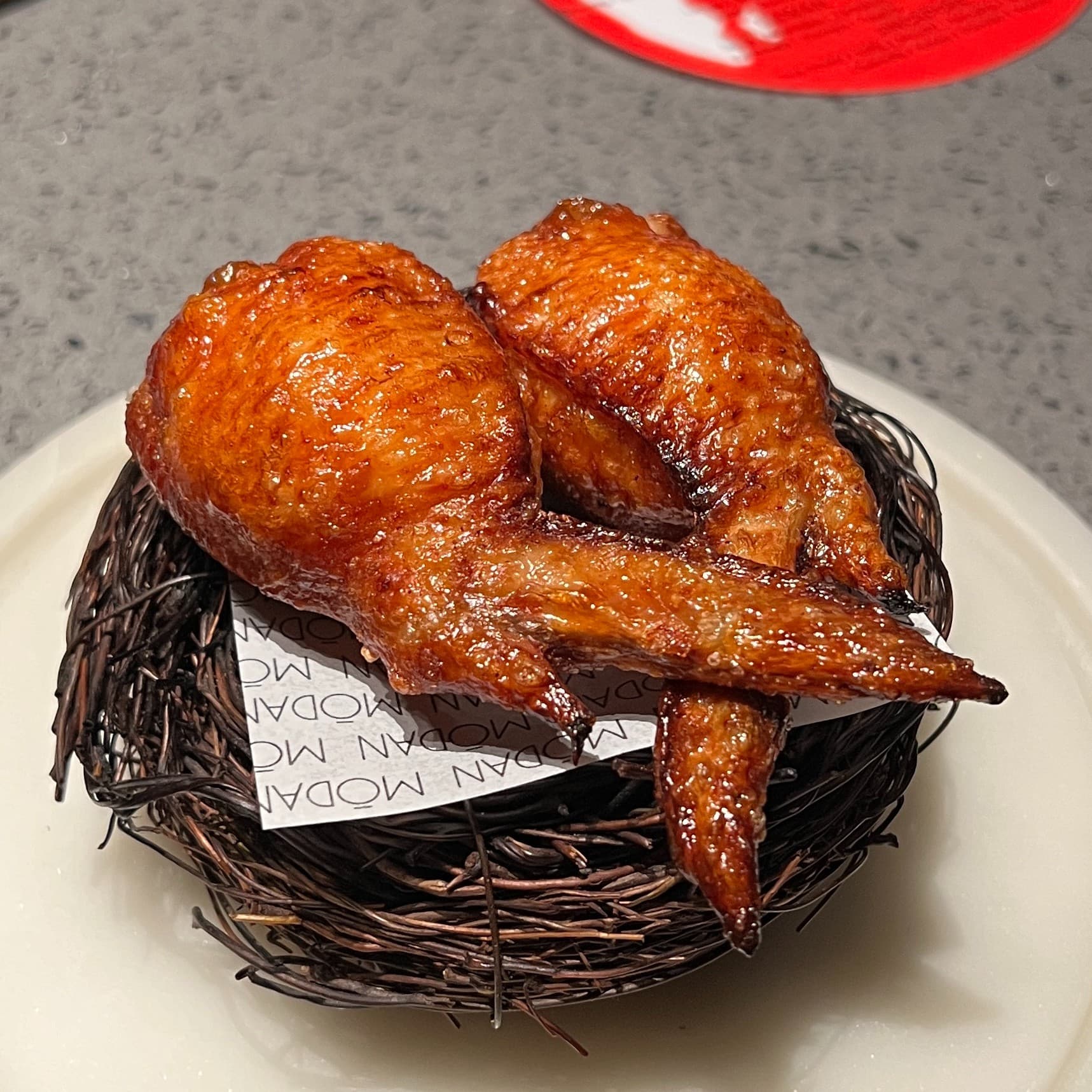 Indonesia Ching Dee
Indonesia Ching Dee
 Indonesia Ching Dee
Indonesia Ching Dee We were instructed to use the chicken wing as a pestle to fully combine the sauce. The chicken wing was hot and crisp with an extremely juicy interior, adding further umami to the gorgeous sauce with hints of curry, miso, sweetness, and little pops of tartness from the goji berries. We were also asked to save half of the sauce for the next course, which was very difficult to do because I just wanted to slurp that sauce straight out of the marble mortar it came in.
We were instructed to use the chicken wing as a pestle to fully combine the sauce. The chicken wing was hot and crisp with an extremely juicy interior, adding further umami to the gorgeous sauce with hints of curry, miso, sweetness, and little pops of tartness from the goji berries. We were also asked to save half of the sauce for the next course, which was very difficult to do because I just wanted to slurp that sauce straight out of the marble mortar it came in.
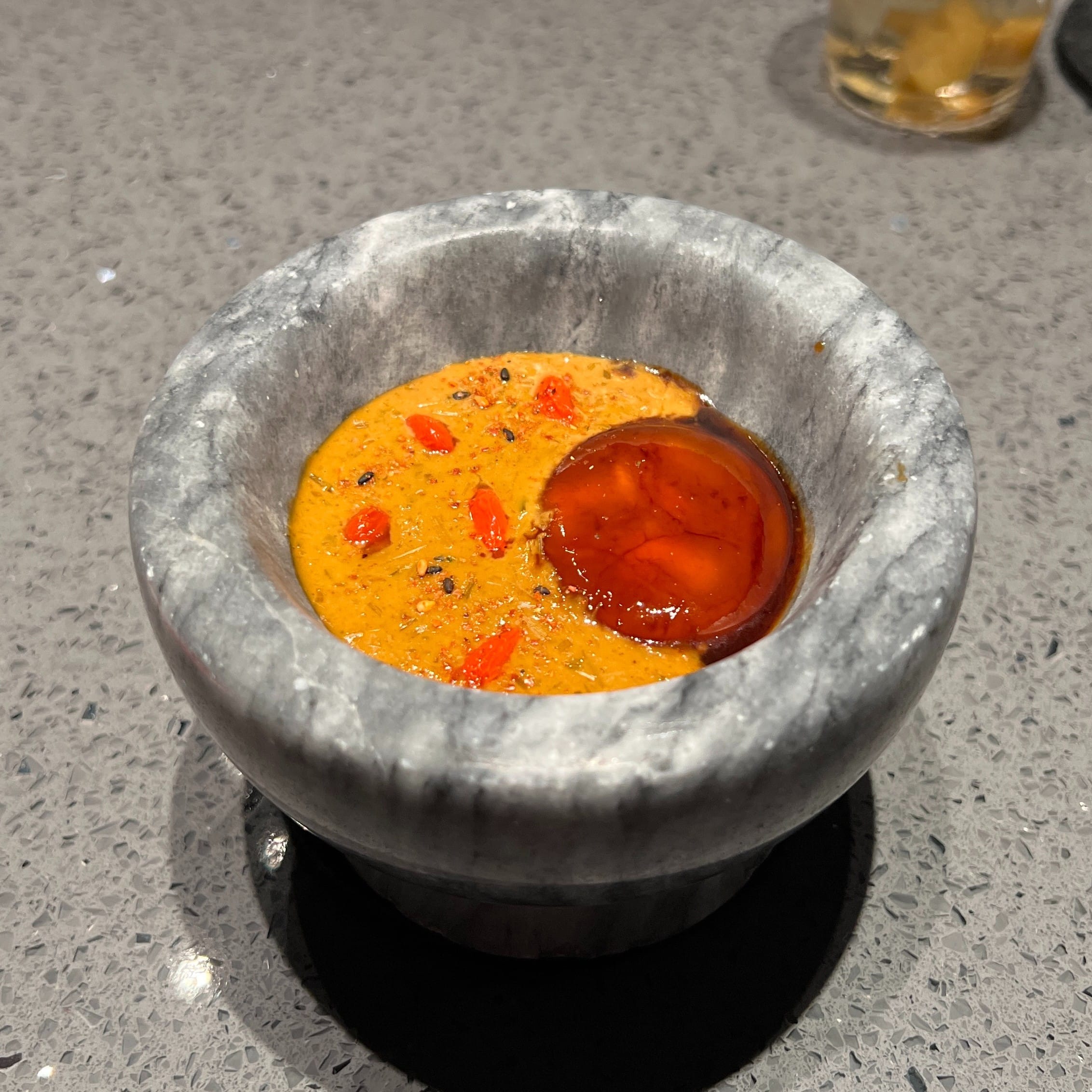 That sauce! Ching Dee
That sauce! Ching Dee
 That sauce! Ching Dee
That sauce! Ching Dee CAMBODIA
Saving some sauce from the Indonesia course made sense when we were presented with a Cambodia-inspired dish. They gave us a piece of focaccia bread dusted with some kind of powdered dried fish and some wakame compound butter on the side.
Saving some sauce from the Indonesia course made sense when we were presented with a Cambodia-inspired dish. They gave us a piece of focaccia bread dusted with some kind of powdered dried fish and some wakame compound butter on the side.
Like the previous course, we were encouraged to use our hands and spread the butter on the bread before dunking it into the remaining sauce. As a lover of sauces and dips, I made sure I mopped up as much of the sauce using my bread. It was so freakin’ good. So simple yet so good. The soft bread had a nice crunchy crust, which also works well for scooping the sauce. The curry-forward sauce contrasted nicely with the buttery bread. While it has familiar flavors, this course is still completely different and I appreciate the thought behind subtle changes with a drastic impact.
Like the previous course, we were encouraged to use our hands and spread the butter on the bread before dunking it into the remaining sauce. As a lover of sauces and dips, I made sure I mopped up as much of the sauce using my bread. It was so freakin’ good. So simple yet so good. The soft bread had a nice crunchy crust, which also works well for scooping the sauce. The curry-forward sauce contrasted nicely with the buttery bread. While it has familiar flavors, this course is still completely different and I appreciate the thought behind subtle changes with a drastic impact.
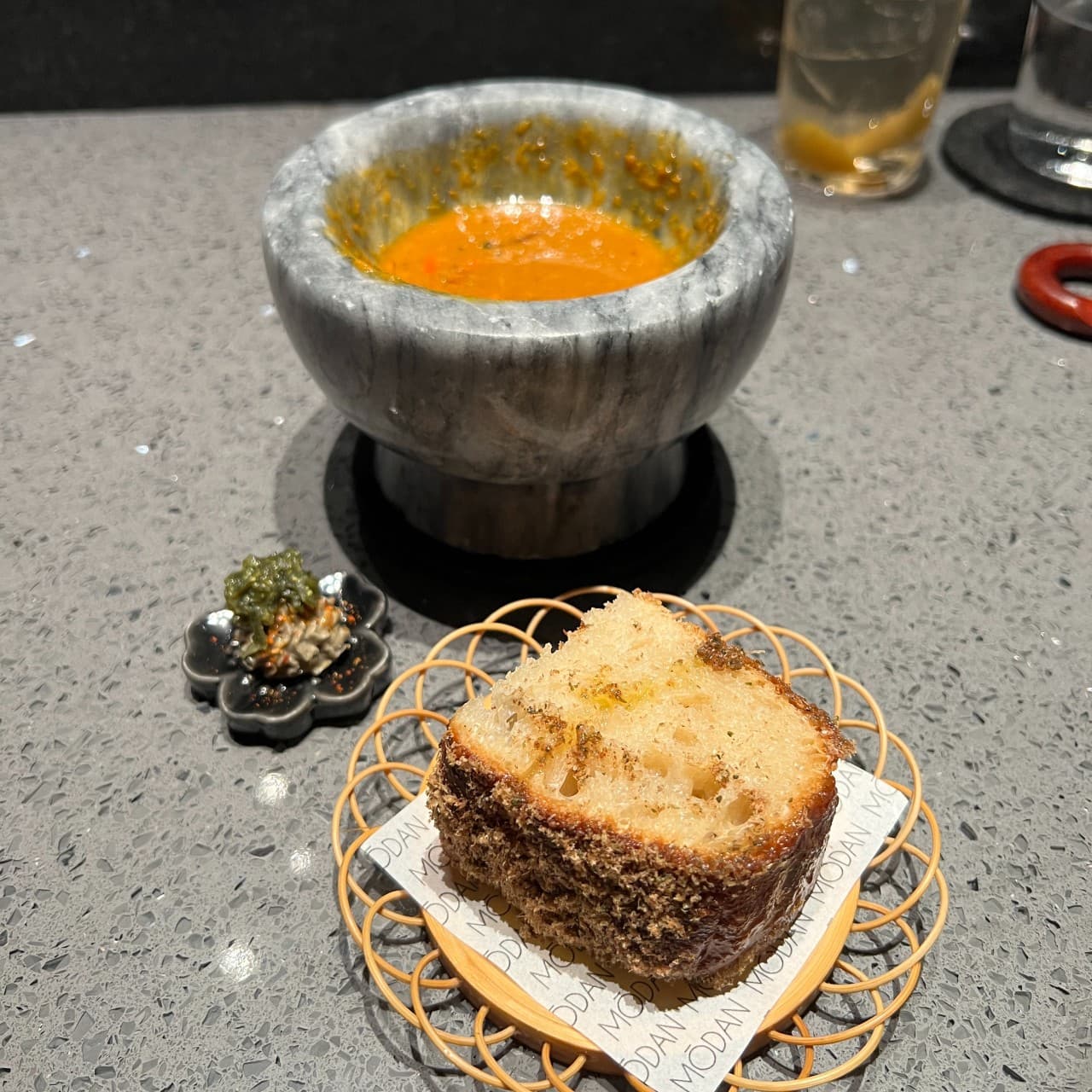 Cambodia Ching Dee
Cambodia Ching Dee
 Cambodia Ching Dee
Cambodia Ching Dee VIETNAM
In this delightful fusion of Vietnamese and Japanese cuisine, Mōdan made thick and creamy ca ri (Vietnamese curry) to go with the natural sweetness of delicate Snow Crab. We savored the subtle curry flavors of the sauce as it clung to the house-made udon, thick and pleasantly chewy.
In this delightful fusion of Vietnamese and Japanese cuisine, Mōdan made thick and creamy ca ri (Vietnamese curry) to go with the natural sweetness of delicate Snow Crab. We savored the subtle curry flavors of the sauce as it clung to the house-made udon, thick and pleasantly chewy.
We were once again instructed to save some of the noodles and ca ri sauce for another transformation and we happily obliged. After eating the meat off the Snow Crab claw like a savory lollipop while dipping it in the thick ca ri, they poured a warm broth laced with matcha, turning the thick ca ri into a hearty soup. Like the Tom Yum, I also savored every drop of the soup, which had a pleasant bitterness, thanks to the matcha, to balance the richness of the ca ri.
We were once again instructed to save some of the noodles and ca ri sauce for another transformation and we happily obliged. After eating the meat off the Snow Crab claw like a savory lollipop while dipping it in the thick ca ri, they poured a warm broth laced with matcha, turning the thick ca ri into a hearty soup. Like the Tom Yum, I also savored every drop of the soup, which had a pleasant bitterness, thanks to the matcha, to balance the richness of the ca ri.
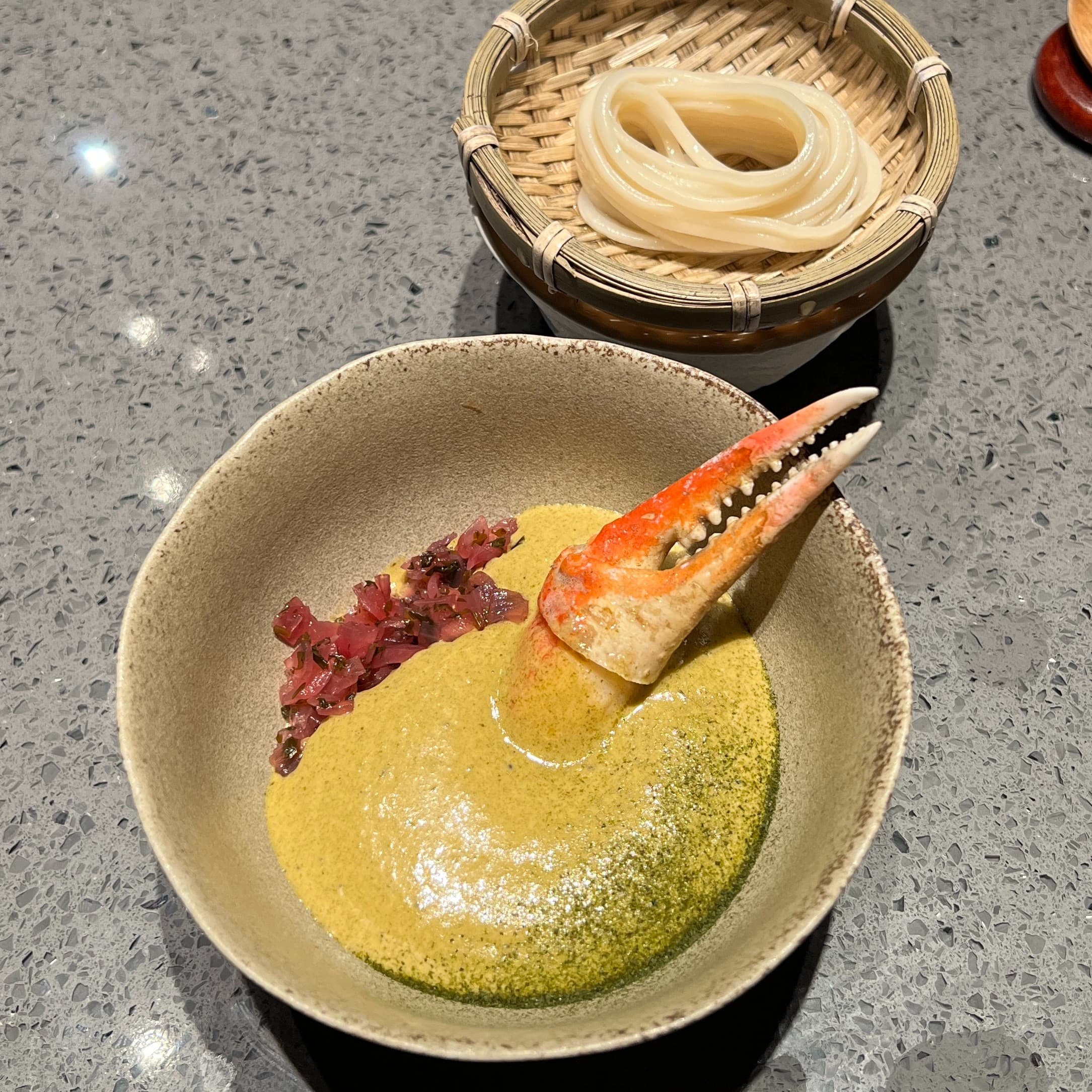 Vietnam Ching Dee
Vietnam Ching Dee
 Vietnam Ching Dee
Vietnam Ching Dee TAIWAN
This dish celebrates Taiwanese and Japanese cuisine with a distinct Jorge Mendez flair. Reminiscent of claypot rice, steamed Japanese rice is mixed with various ingredients like namako (sea cucumber), chewy tendon, and tiny balls of chewy dango (sweet rice dumplings). Then it’s topped with fluffy and light tamago (egg omelette) and lastly a crispy unagi katsu (battered and deep-fried eel) is cut on top of the rice before serving, so it maintains its crispness.
This dish celebrates Taiwanese and Japanese cuisine with a distinct Jorge Mendez flair. Reminiscent of claypot rice, steamed Japanese rice is mixed with various ingredients like namako (sea cucumber), chewy tendon, and tiny balls of chewy dango (sweet rice dumplings). Then it’s topped with fluffy and light tamago (egg omelette) and lastly a crispy unagi katsu (battered and deep-fried eel) is cut on top of the rice before serving, so it maintains its crispness.
All diners were advised to mix everything together but not to scrape the bottom of the pot too hard, as we wait for the okage or crispy rice to form at the bottom (much like the socarrat in paella). Before we finished all the rice, one of the staff took the pot and scraped all the okage for us, making it easier for us to enjoy the crispy, caramelized rice. The rice was sublime, but I really enjoyed the unagi katsu — the unagi was tender, flaky, and flavorful without any fishy taste; the crispy coating was light and crunchy, giving a good contrast of texture for the rest of the dish. And Chef Jorge and his team surprised everyone with slices of A5 Wagyu Beef Katsu, because he said, “It wouldn’t be Mōdan without a surprise dish.”
All diners were advised to mix everything together but not to scrape the bottom of the pot too hard, as we wait for the okage or crispy rice to form at the bottom (much like the socarrat in paella). Before we finished all the rice, one of the staff took the pot and scraped all the okage for us, making it easier for us to enjoy the crispy, caramelized rice. The rice was sublime, but I really enjoyed the unagi katsu — the unagi was tender, flaky, and flavorful without any fishy taste; the crispy coating was light and crunchy, giving a good contrast of texture for the rest of the dish. And Chef Jorge and his team surprised everyone with slices of A5 Wagyu Beef Katsu, because he said, “It wouldn’t be Mōdan without a surprise dish.”
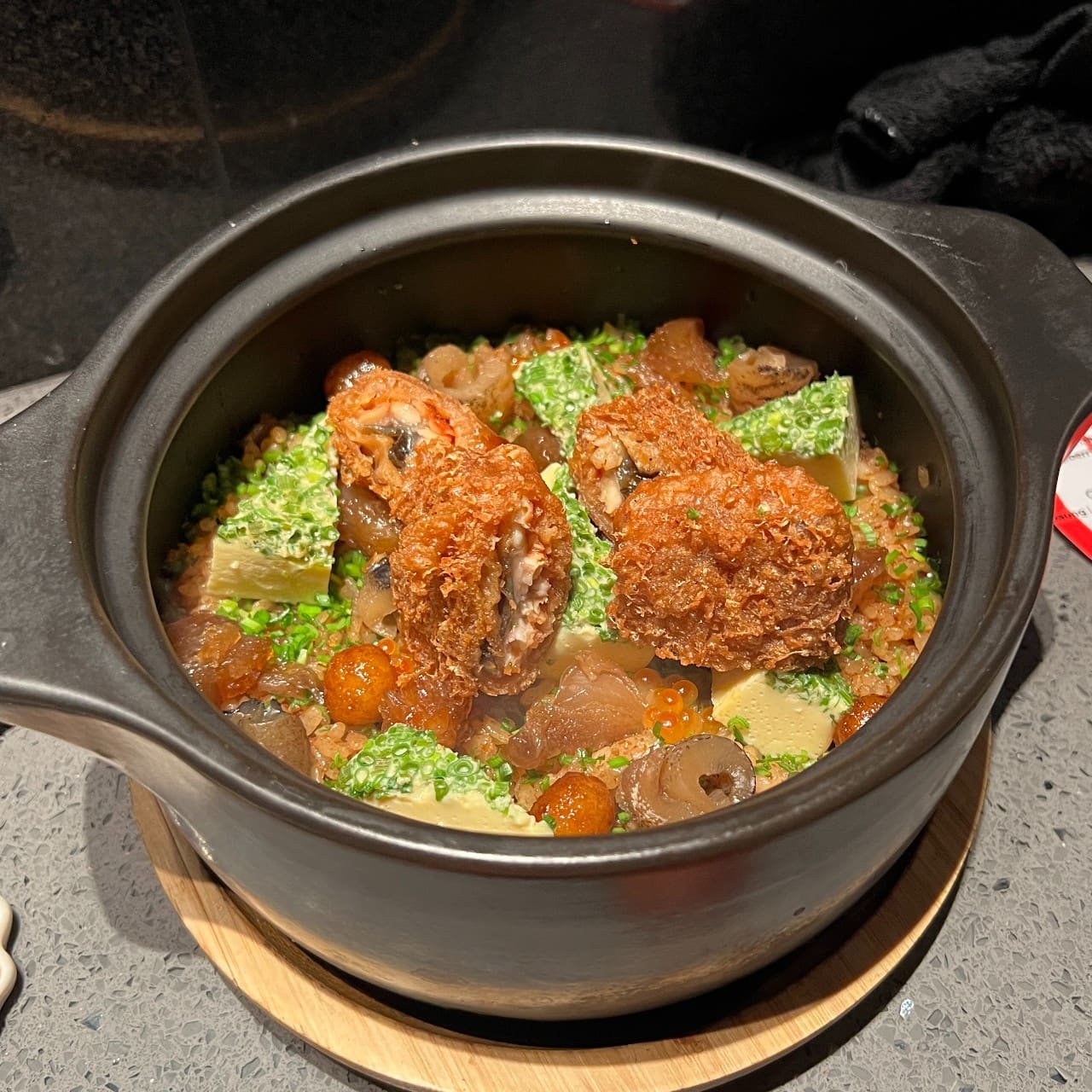 Taiwan Ching Dee
Taiwan Ching Dee
 Taiwan Ching Dee
Taiwan Ching Dee Various Japanese-inspired vegetable and fruit pickles were served on the side to balance the flavors. I especially loved the pickled apples, which were fruity sweet and tangy while still maintaining its succinct crunch. It’s a nice little refreshing bite in between spoonfuls of flavorful rice and deep-fried unagi.
Various Japanese-inspired vegetable and fruit pickles were served on the side to balance the flavors. I especially loved the pickled apples, which were fruity sweet and tangy while still maintaining its succinct crunch. It’s a nice little refreshing bite in between spoonfuls of flavorful rice and deep-fried unagi.
This dish is hefty, making you forget you are in fact still enjoying a degustation dinner. It’s best shared with someone, but you can definitely have any leftover rice to go if you want (which we would’ve done, but we hardly had any leftovers).
This dish is hefty, making you forget you are in fact still enjoying a degustation dinner. It’s best shared with someone, but you can definitely have any leftover rice to go if you want (which we would’ve done, but we hardly had any leftovers).
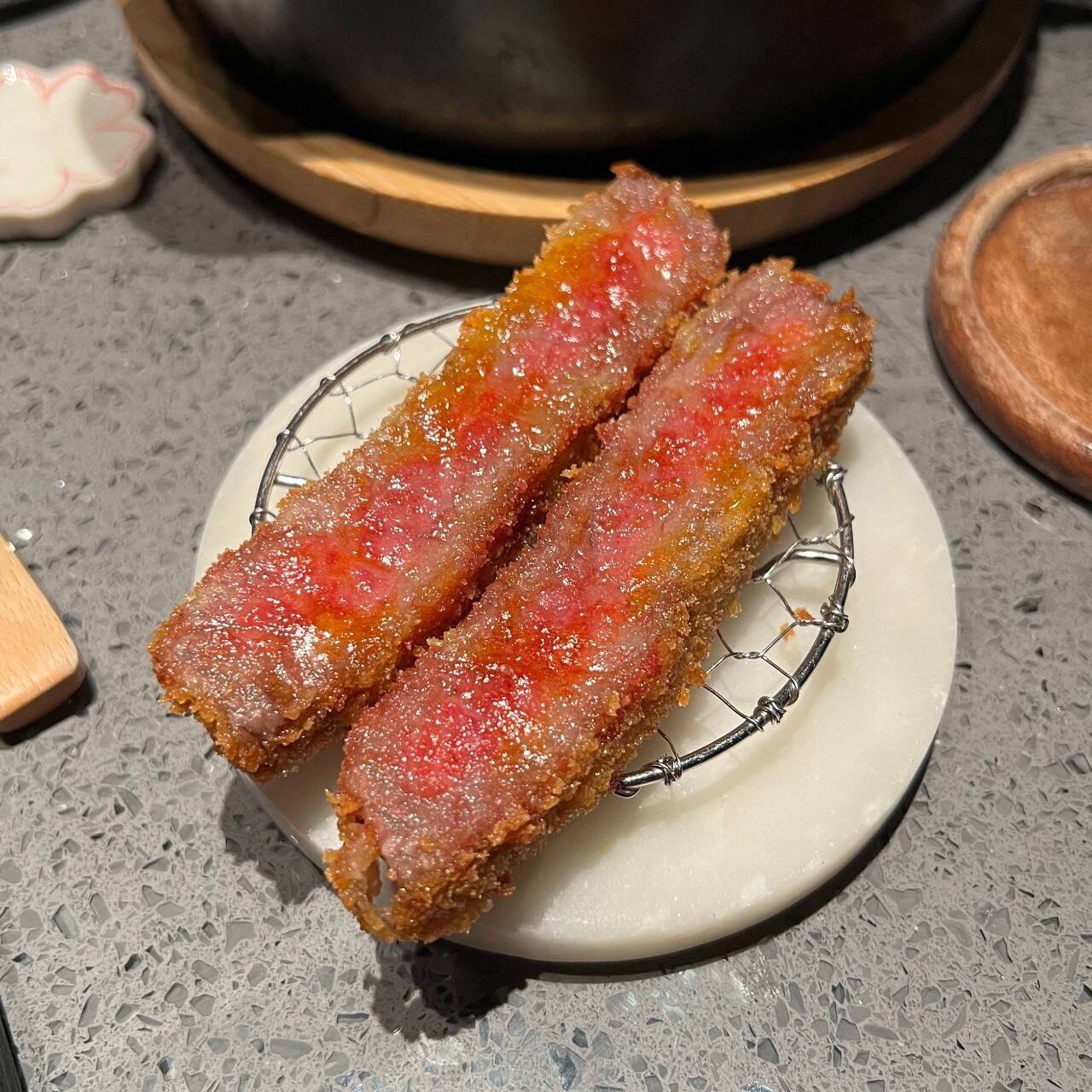 Taiwan: Surprise Wagyu Katsu Ching Dee
Taiwan: Surprise Wagyu Katsu Ching Dee
 Taiwan: Surprise Wagyu Katsu Ching Dee
Taiwan: Surprise Wagyu Katsu Ching Dee SINGAPORE
Despite being a dessert lover, I must admit I was a little bit sad when the time for dessert came. I didn’t want this perfect dinner to end. My sadness though was immediately wiped away at the sight of the dessert duo presented to us.
Despite being a dessert lover, I must admit I was a little bit sad when the time for dessert came. I didn’t want this perfect dinner to end. My sadness though was immediately wiped away at the sight of the dessert duo presented to us.
The flavors of Singapore, a cultural melting pot, were beautifully represented on the two desserts.
The flavors of Singapore, a cultural melting pot, were beautifully represented on the two desserts.
The Castella (sponge cake), which was sitting on a moat of pandan-infused milk, has a subtle Yuzu flavor and is layered with Kaya (coconut jam). For a distinct saltiness, it’s topped with ethically sourced Nomad caviar and you’ll be surprised too with how well this works on creamy desserts. We loooved the pandan milk so much that we sliced the Castella into smaller pieces to soak up as much of the milk as possible, creating a rough bread pudding. The flavors are so familiar, yet Mōdan managed to create magic out of it.
The Castella (sponge cake), which was sitting on a moat of pandan-infused milk, has a subtle Yuzu flavor and is layered with Kaya (coconut jam). For a distinct saltiness, it’s topped with ethically sourced Nomad caviar and you’ll be surprised too with how well this works on creamy desserts. We loooved the pandan milk so much that we sliced the Castella into smaller pieces to soak up as much of the milk as possible, creating a rough bread pudding. The flavors are so familiar, yet Mōdan managed to create magic out of it.
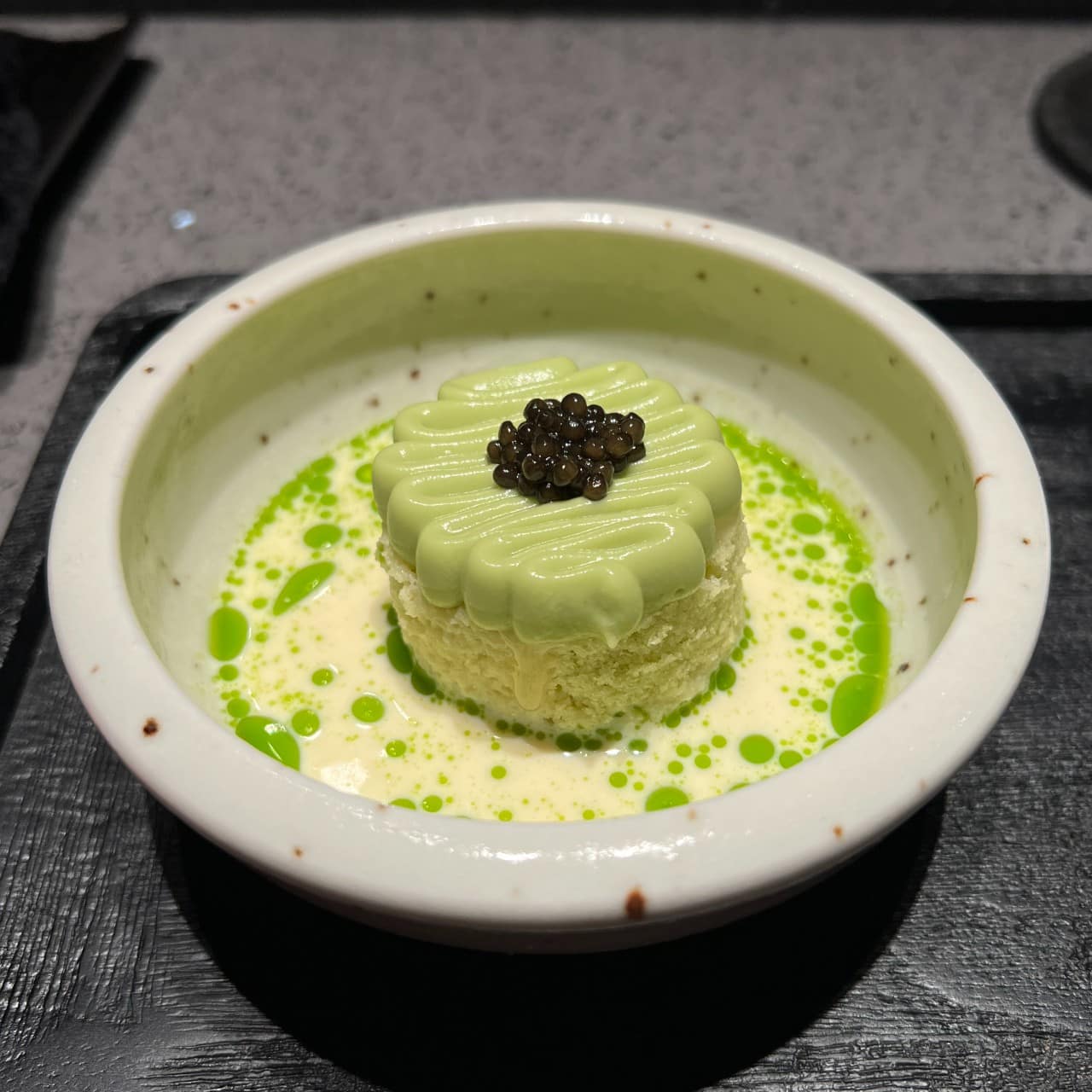 The Castella Ching Dee
The Castella Ching Dee
 The Castella Ching Dee
The Castella Ching Dee The second dessert is their take on mochi but with Southeast Asian ingredients. They made Tua Huay (soybean curd) and encased it in delicate, chewy mochi before dusting it with kinako (roasted soybean flour) for a nutty finish. Underneath, the deep caramel flavor of gula melaka (palm sugar) gives the dessert some depth, going beyond the usual sweetness and offering a more earthy flavor.
The second dessert is their take on mochi but with Southeast Asian ingredients. They made Tua Huay (soybean curd) and encased it in delicate, chewy mochi before dusting it with kinako (roasted soybean flour) for a nutty finish. Underneath, the deep caramel flavor of gula melaka (palm sugar) gives the dessert some depth, going beyond the usual sweetness and offering a more earthy flavor.
Both desserts weren’t overly sugary, instead it showcased how sweetness — and how it’s balanced by other flavors — creates a satisfying end to a meal that you didn’t want to end.
Both desserts weren’t overly sugary, instead it showcased how sweetness — and how it’s balanced by other flavors — creates a satisfying end to a meal that you didn’t want to end.
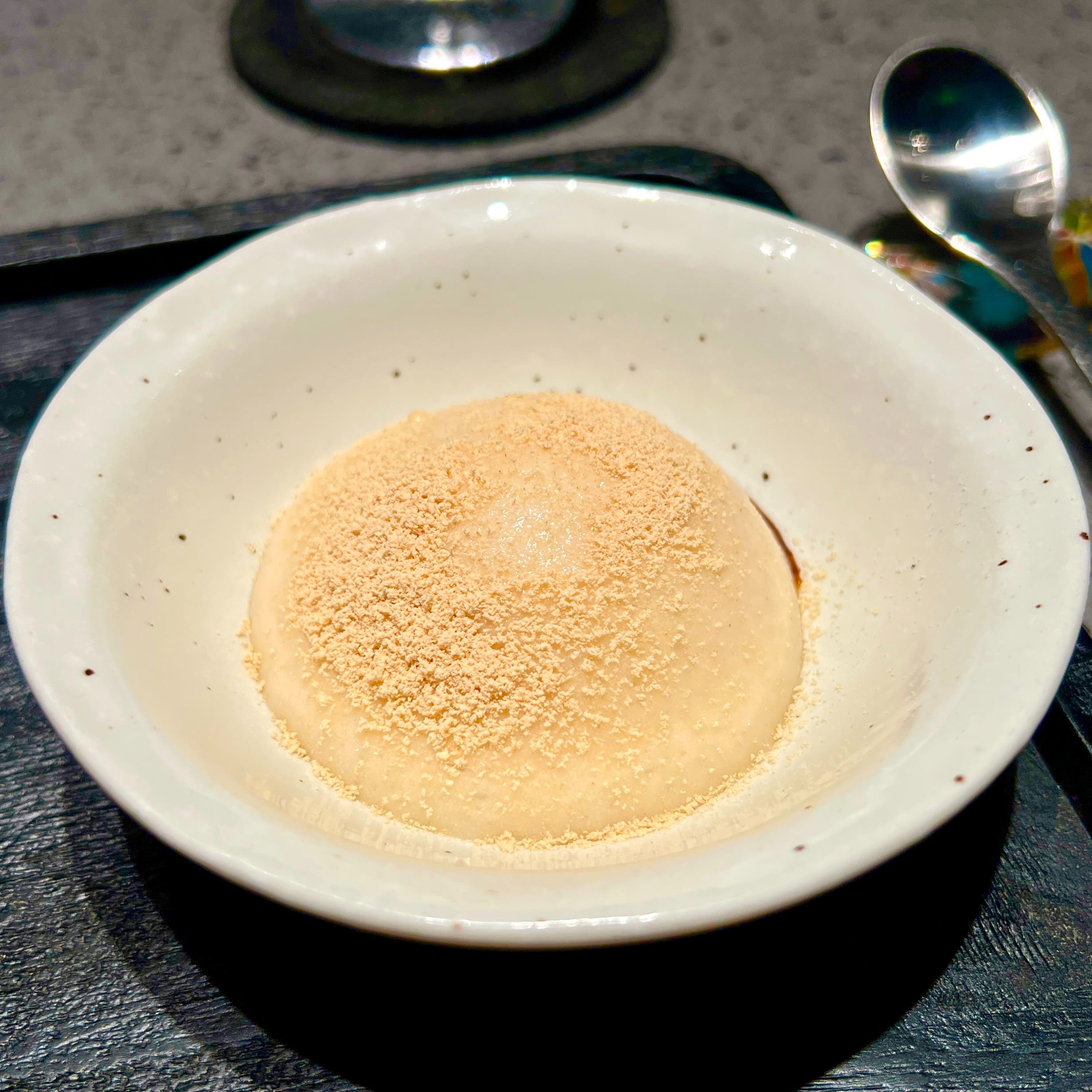 Tua Huay Ching Dee
Tua Huay Ching Dee
 Tua Huay Ching Dee
Tua Huay Ching Dee Let me also just point out that this is the quietest and most relaxed professional kitchen I have ever seen. The whole set-up leaves the Mōdan team vulnerable in every angle, surrounded by a bunch of curious foodies eager to watch — and film! — almost every move. But instead of loud warnings (“behind!”) or anxious fumblings, we witnessed a team of kitchen pros doing what they do best with grace and exact movements, almost like a choreographed dance delivering a delicious performance. Even the guys outside the kitchen, the servers, were very well-spoken and attentive. Sometimes I dread such intimate dinners because of awkward conversations, but we didn’t have any awkward moments (or questions) while we were at Mōdan. And this speaks a lot about how Chef Jorge honed his team and how he inspires them to always give their best at every service.
Let me also just point out that this is the quietest and most relaxed professional kitchen I have ever seen. The whole set-up leaves the Mōdan team vulnerable in every angle, surrounded by a bunch of curious foodies eager to watch — and film! — almost every move. But instead of loud warnings (“behind!”) or anxious fumblings, we witnessed a team of kitchen pros doing what they do best with grace and exact movements, almost like a choreographed dance delivering a delicious performance. Even the guys outside the kitchen, the servers, were very well-spoken and attentive. Sometimes I dread such intimate dinners because of awkward conversations, but we didn’t have any awkward moments (or questions) while we were at Mōdan. And this speaks a lot about how Chef Jorge honed his team and how he inspires them to always give their best at every service.
With utter sincerity, this is one of the best meals I’ve ever had in my life. They say nothing’s perfect, yet here’s Mōdan. If that meal wasn’t perfect, it comes pretty damn well close to it.
With utter sincerity, this is one of the best meals I’ve ever had in my life. They say nothing’s perfect, yet here’s Mōdan. If that meal wasn’t perfect, it comes pretty damn well close to it.
 and chef jorge mendez (middle).jpg) The author with her husband and Chef Jorge Mendez Ching Dee
The author with her husband and Chef Jorge Mendez Ching Dee
 and chef jorge mendez (middle).jpg) The author with her husband and Chef Jorge Mendez Ching Dee
The author with her husband and Chef Jorge Mendez Ching Dee Mōdan | G/F Escalades East Tower, 20th Avenue, Cubao, Quezon City | Open Wednesday to Sunday, 5:30pm & 8:30pm | Reservations required, | Website: modanmnl.ph | Socials: @modan.mnl
Related Story: By Sonja Bakery Is The New Go-To For Dessert Lovers
Photos by Ching Dee
ADVERTISEMENT
ADVERTISEMENT


